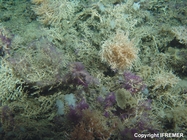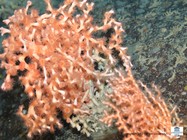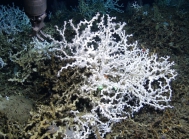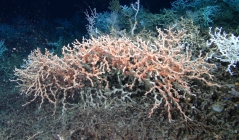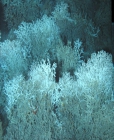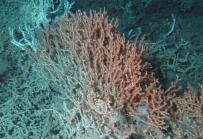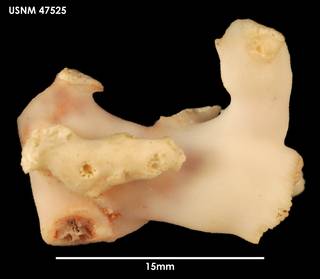WoRMS name details
Lophelia pertusa (Linnaeus, 1758)
135161 (urn:lsid:marinespecies.org:taxname:135161)
unaccepted > superseded combination
Species
marine, fresh, terrestrial
(of Madrepora pertusa Linnaeus, 1758) Linnaeus, C. (1758). Systema Naturae per regna tria naturae, secundum classes, ordines, genera, species, cum characteribus, differentiis, synonymis, locis. [The system of nature through the three kingdoms of nature, according to classes, orders, genera, species, with characters, differences, synonyms, places.]. <em>Impensis Direct. Laurentii Salvii. Holmiae [Stockholm].</em> 1(10) [iii], 824 p., available online at https://biodiversitylibrary.org/page/726886 [details] Available for editors  [request]
[request]
Taxonomic remark Based on molecular evidence, Addamo et al. (2012) first suggested that Lophelia be synonymized with Desmophyllum, and later...
Depth range 39-2775 m
Distribution in Nova Scotia waters; Nova Scotia south to New Jersey
Distribution semi-cosmopolitan
Taxonomic remark Based on molecular evidence, Addamo et al. (2012) first suggested that Lophelia be synonymized with Desmophyllum, and later Addamo et al. (2016) formally stated that Lophelia was a junior synonym. The basic difference between the two taxa is that Desmophyllum is solitary and Lophelia colonial, which to a traditional morphologist like me (S. Cairns) is a significant one. Since the molecular results seemed convincing to me, I asked the opinion of three molecular biologists that work with Scleractinia. They were all somewhat skeptical, or rather cautious, concerning the immediate need for a taxonomic change that would synonymize Lophelia. Lophelia is one of the few cosmopolitan scleractinian species, and is also one of the most studied species in the order, especially in the North Atlantic. To change its nomenclature with the possibility that it might have to revert to the original would cause much taxonomic confusion. My molecular colleagues convinced me to be cautious and wait for the next two or three studies to be published on the matter, in which more genes may be used. I therefore represent the minority view of view on this matter in suggesting maintaining the name Lophelia pertusa until more study is done. S. Cairns 2019 [details]
Depth range 39-2775 m
Depth range 39-2775 m [details]
Distribution in Nova Scotia waters; Nova Scotia south to New Jersey
Distribution in Nova Scotia waters; Nova Scotia south to New Jersey [details]
Distribution semi-cosmopolitan
Distribution semi-cosmopolitan [details]
Hoeksema, B. W.; Cairns, S. (2025). World List of Scleractinia. Lophelia pertusa (Linnaeus, 1758). Accessed through: World Register of Marine Species at: https://www.marinespecies.org/aphia.php?p=taxdetails&id=135161 on 2025-04-04
Date
action
by
![]() The webpage text is licensed under a Creative Commons
Attribution 4.0 License
The webpage text is licensed under a Creative Commons
Attribution 4.0 License
Nomenclature
original description
(of Madrepora pertusa Linnaeus, 1758) Linnaeus, C. (1758). Systema Naturae per regna tria naturae, secundum classes, ordines, genera, species, cum characteribus, differentiis, synonymis, locis. [The system of nature through the three kingdoms of nature, according to classes, orders, genera, species, with characters, differences, synonyms, places.]. <em>Impensis Direct. Laurentii Salvii. Holmiae [Stockholm].</em> 1(10) [iii], 824 p., available online at https://biodiversitylibrary.org/page/726886 [details] Available for editors  [request]
[request]
basis of record Cairns, S.D., Hoeksema, B.W., and J. van der Land, 2001. Scleractinia, <B><I>in</I></B>: Costello, M.J. <i>et al.</i> (Ed.) (2001). <i>European register of marine species: a check-list of the marine species in Europe and a bibliography of guides to their identification. Collection Patrimoines Naturels,</i> 50: pp. 109-110 (look up in IMIS) [details]
basis of record Cairns, S.D., Hoeksema, B.W., and J. van der Land, 2001. Scleractinia, <B><I>in</I></B>: Costello, M.J. <i>et al.</i> (Ed.) (2001). <i>European register of marine species: a check-list of the marine species in Europe and a bibliography of guides to their identification. Collection Patrimoines Naturels,</i> 50: pp. 109-110 (look up in IMIS) [details]
Taxonomy
source of synonymy
Zibrowius H. (1980). Les scléractiniaires de la Méditerranée et de l'Atlantique nord-oriental. <em>Mémoires de l'Institut océanographique, Monaco.</em> 11: 1-284, pls. 1-117. (look up in IMIS)
page(s): 126 [details] Available for editors [request]
[request]
redescription Cairns, S.D. (2000). A revision of the shallow-water azooxanthellate Scleractinia of the western Atlantic. <em>Studies on the Natural History of the Caribbean Region.</em> 75: 1-231. [details] Available for editors [request]
[request]
redescription Cairns, S.D. (1994). Scleractinia of the temperate North Pacific. <em>Smithsonian Contributions to Zoology.</em> 557: 1-150. [details] Available for editors [request]
[request]
page(s): 126 [details] Available for editors
redescription Cairns, S.D. (2000). A revision of the shallow-water azooxanthellate Scleractinia of the western Atlantic. <em>Studies on the Natural History of the Caribbean Region.</em> 75: 1-231. [details] Available for editors
redescription Cairns, S.D. (1994). Scleractinia of the temperate North Pacific. <em>Smithsonian Contributions to Zoology.</em> 557: 1-150. [details] Available for editors
Ecology
ecology source
Roberts, J.M., A. Wheeler, A. Freiwald & S.D. Cairns. (2009). Cold-water corals: The biology and geology of deep-sea coral habitats. <em>Cambridge University Press, Cambridge, UK.</em> 324 pp. [details] Available for editors  [request]
[request]
Other
context source (Deepsea)
Cairns, Stephen (look up in IMIS) [details]
context source (Bermuda) Cairns, S.D. (2000). A revision of the shallow-water azooxanthellate Scleractinia of the western Atlantic. <em>Studies on the Natural History of the Caribbean Region.</em> 75: 1-231. [details] Available for editors [request]
[request]
context source (Hexacorallia) Fautin, Daphne G. (2013). Hexacorallians of the World. (look up in IMIS) [details]
additional source Breeze, H., D.S. Davis, M. Butler, and V. Kostylev. 1997. Distribution and status of deep sea corals off Nova Scotia. Ecology Action Centre. Halifax. 58 p. [details]
additional source Cairns, S.D., D.R. Calder, A. Brinckmann-Voss, C.B. Castro, P.R. Pugh, C.E. Cutress, W.C. Jaap, D.G. Fautin, R.J. Larson, G.R. Harbison, M.N. Arai & D.M. Opresko. (1991). Common and scientific names of aquatic invertebrates of the United States and canada. <em>Cnidaria and Ctenophora. American Fisheries Society, Bethesda.</em> 75: pp. [details]
additional source Integrated Taxonomic Information System (ITIS). , available online at http://www.itis.gov [details]
additional source Jensen, A. & R. Frederiksen, 1992. The fauna associated with the bank-forming deepwater coral Lophelia pertusa (Scleractinia) on the Faroe shelf. Sarsia 77 1: 53-69.
page(s): 53-61 [details]
additional source Cairns, S.D., B.W. Hoeksema & J. van der Land. (1999). Appendix: List of extant stony corals. <em>Atoll Research Bulletin.</em> 459: 13-46.
page(s): 22 [details]
additional source Grygier, M.J. (1991). Introcornia (Crustacea : Ascothoracida : Petrarcidae) parasitic in an ahermatypic coral from Saint Paul Island, Indian Ocean. <em>Vie et Milieu.</em> 40(4): 313-318. [dated 1990].
page(s): 313, 317, 318 [details]
additional source Cairns, S.D., W.C. Jaap & J.C. Lang. (2009). Scleractinia (Cnidaria) of the Gulf of Mexico. <em>In: Felder DL. Camp DK (eds.) Gulf of Mexico–Origins, Waters, and Biota. Biodiversity. Texas A&M Press, College Station, Texas.</em> Pp. 333–347. [details] Available for editors [request]
[request]
additional source Cairns, S.D. (2009-2017). On line appendix: Phylogenetic list of the 711 valid Recent azooxanthellate scleractinian species with their junior synonyms and depth ranges, 28 pp. <em>In: Cold-Water Corals: The Biology and Geology of Deep-Sea Coral Habitats.</em> Cambridge University Press, Cambridge. [details]
additional source Kitahara, M.V. & S.D. Cairns. (2005). Monohedotrochus capitolii, a new genus and species of solitary azooxanthellate coral (Scleractinia, Caryophylliidae) from southern Brazil. <em>Zoologische Mededelingen, Leiden.</em> 79-2 (5): 115-121.
page(s): 116 [details] Available for editors [request]
[request]
additional source Cairns, S.D. (1999). Cnidaria Anthozoa: Deep-water azooxanthellate Scleractinia from Vanuatu, and Wallis and Futuna Islands. <em>In: Crosnier, A. (Ed.) Résultats des Campagnes MUSORSTOM 20. Mémoires du Muséum national d'Histoire naturelle. Série A, Zoologie.</em> 20(180): 31-167. (look up in IMIS) [details] Available for editors [request]
[request]
additional source Reyes, J., N. Santodomingo & S.D. Cairns. (2009). Caryophylliidae (Scleractinia) from the Colombian Caribbean. <em>Zootaxa.</em> 2262: 1-39. [details] Available for editors [request]
[request]
additional source Cairns, S.D. & H. Zibrowius. (1997). Cnidaria Anthozoa: Azooxanthellate Scleractinia from the Philippine and Indonesian regions. <em>in: Crosnier, A. et al. (Ed.) Résultats des Campagnes MUSORSTOM 16. Campagne Franco-Indonésienne KARUBAR. Mémoires du Muséum national d'Histoire naturelle. Série A, Zoologie.</em> 172: 27-244. (look up in IMIS)
page(s): 59 [details] Available for editors [request]
[request]
additional source Cedhagen, T. (1994). Taxonomy and biology of <i>Hyrrokkin sarcophaga</i> gen. et sp. n., a parasitic foraminiferan (Rosalinidae). <em>Sarsia.</em> 79(1): 65-82., available online at https://doi.org/10.1080/00364827.1994.10413549
page(s): 65, 67, 74 [details] Available for editors [request]
[request]
additional source Benzoni, F., Stefani, F., Stolarski, J., Pichon, M., Mitta, G., Galli, P. 2007. Debating phylogenetic relationships of the scleractinian Psammocora: molecular and morphological evidences. Contributions to Zoology 76: 35-54., available online at https://doi.org/10.1163/18759866-07601004
page(s): 39 [details] Available for editors [request]
[request]
additional source Fenner, D. (2001). Biogeography of three Caribbean corals (Scleractinia) and the invasion of Tubastraea coccinea into the Gulf of Mexico. <em>Bulletin of Marine Science.</em> 69: 1175-1189., available online at http://www.ingentaconnect.com/content/umrsmas/bullmar/2001/00000069/00000003/art00010?crawler=true
page(s): 1179 [details] Available for editors [request]
[request]
additional source Kitahara, M.V., S.D. Cairns & D.J. Miller. (2010). Monophyletic origin of Caryophyllia (Scleractinia, Caryophylliidae), with descriptions of six new species. <em>Systematics and Biodiversity.</em> 8(1): 91-118., available online at https://doi.org/10.1080/14772000903571088
page(s): 91 [details] Available for editors [request]
[request]
additional source Reyes-Bonilla, H. (2002). Checklist of valid names and synonyms of stony corals (Anthozoa: Scleractinia) from the eastern Pacific. <em>Journal of Natural History.</em> 36(1): 1-13., available online at https://doi.org/10.1080/713833841 [details]
additional source Zabala, M.; Maluquer, P.; Harmelin, J.-G. (1993). Epibiotic bryozoans on deep-water scleractinian corals from the Catalonia Slope (western Mediterranean, Spain, France). <em>Scientia Marina.</em> 57: 65-78.
page(s): 65, 66, 67, 74 [details] Available for editors [request]
[request]
additional source Zibrowius, H.; Gili, J.-M. (1990). Deep-water Scleractinia (Cnidaria: Antbozoa) from Namibia, South Africa, and Walvis Ridge, southeastern Atlantic. <em>Scientia Marina.</em> 54 (1): 19-46.
page(s): 36-37 [details] Available for editors [request]
[request]
additional source Zibrowius, H.; Taviani, M. (2005). Remarkable sessile fauna associated with deep coral and other calcareous substrates in the Strait of Sicily, Mediterranean Sea. <i>in</i> Freiwald A, Roberts JM (eds), Cold-water Corals and Ecosystems. Springer-Verlag Berlin Heidelberg, pp 807-819.
page(s): 810, 811 [details] Available for editors [request]
[request]
additional source Rogers, A. D. (1999). The biology of Lophelia pertusa (Linnaeus, 1758) and other deep-water reef-forming corals and impacts from human activities. International Review of Hydrobiology, 84: 315-406
page(s): 315-325, 327, 330-353, 355-358 [details]
additional source Reyes J, Santodomingo N, Flórez P. (2010). Corales Escleractinios de Colombia. <em>Instituto de Investigaciones Marinas y Costeras (INVEMAR), Santa Marta, Colombia.</em> pp 1-246. [details]
additional source Ocaña O, de Matos V, Aguilar R, García S, Brito A. (2017). Illustrated catalogue of cold water corals (Cnidaria: Anthozoa) from Alboran basin and North Eastern Atlantic submarine mountains, collected in Oceana campaigns. <em>Rev. Acad. Canar. Cienc.</em> 29: 221-256. [details]
additional source Brito A, Ocaña O. (2004). Corals of the Canary Islands. Skeleton anthozoans of the littoral and deep bottoms. <em>Francisco Lemus, La Laguna.</em> 1-477 pp. [details]
additional source Kitahara MV. (2007). Species richness and distribution of azooxanthellate Scleractinia in Brazil. <em>Bulletin of Marine Science.</em> 81 (3): 497-518. [details]
additional source den Hartog, J. C. (1980). Caribbean Shallow Water Corallimorpharia. Zoologische Verhandelingen, (176): 83 pp.
page(s): 69 [details]
additional source Pires DE. (2007). The azooxanthellate coral fauna of Brazil. <em>Bulletin of Marine Science.</em> 81:265-272. [details]
additional source Santodomingo, N.; Reyes, J.; Flórez, P.; Chacón-Gómez, I.C.; van Ofwegen, L.P.; Hoeksema, B.W. (2012). Diversity and distribution of azooxanthellate corals in the Colombian Caribbean. <em>Marine Biodiversity.</em> 43(1): 7-22., available online at https://doi.org/10.1007/s12526-012-0131-6 [details]
additional source Zibrowius, H. (1974). Scleractiniares des Iles Saint Paul et Amsterdam (sud de L'Ocean Indien). Tethys, 5(4): 747-778
page(s): 747, 761-762, Pl. 2, fig. 6-9 [details]
additional source Pax, F.; Müller, I. (1962). Die Anthozoenfauna der Adria / Fauna antozoa Jadrana. Fauna et Flora Adriatica, 3, 1-343
page(s): 246-248 [details]
additional source Carlgren, O. (1945). Polypdyr (Coelenterata) III. Koraldyr. Danmarks Fauna Udgivet af Dansk Naturhistorisk Forening, 51, 3-167
page(s): 151-152, 157 [details]
additional source Försterra, G.; Häussermann, V. (2003). First report on large scleractinian (Cnidaria: Anthozoa) accumulations in cold-temperate shallow water of south Chilean fjords. Zoologische Verhandelingen, 345, 117-128
page(s): 117-118 [details]
additional source Maier, E.; Tollrian, R.; Rinkevich, B.; Nürnberger, B. (2005). Isolation by distance in the scleractinian coral Seriatopora hystrix from the Red Sea. Marine Biology, 147, 1109-1120
page(s): 1110, 1116 [details]
additional source Fosshagen, A.; HøisSter, T. (1992). The second Norwegian record of the deep-water coral, Desmophyllum cristagalli Milne-Edwards & Haime, 1848 (Cnidaria: Scleractinia). Sarsia, 77, 291-292
page(s): 291, 292 [details]
additional source Pax, F. (1956). La conoscenza degli antozoi Adriatici fino alla fine del secolo XVIII. Bollettino della Società Adriatica di Scienze Naturali, 48, 50-61
page(s): 51-52, 57, 59 [details]
additional source Jonsson, L. G.; Nilsson, P. G.; Floruta, F.; Lundälv, T. (2004). Distributional patterns of macro- and megafauna associated with a reef of the cold-water coral Lophelia pertusa on the Swedish west coast. Marine Ecology Progress Series, 284, 163-171
page(s): 163-170 [details]
additional source Schröder-Ritzrau, A.; Freiwald, A.; Mangini, A. (2005). U/Th-dating of deep-water corals from the eastern North Atlantic and the western Mediterranean Sea. André Freiwald and J. Murray Roberts (eds.). Springer. Verlag Berlin Heidelberg, pp. 157-172
page(s): 158, 160, 161 [details]
additional source Álvarez-Pérez, G.; Busquets, P.; De Mol, B.; Sandoval, N. G.; Canals, M.; Casamor, J. L. (2005). Deep-water coral occurrences in the Strait of Gibraltar. André Freiwald and J. Murray Roberts (eds.). Springer. Verlag Berlin Heidelberg, pp. 207-221
page(s): 207, 208, 209, 212, 213, 217 [details]
additional source Gass, S. E.; Willison, M. J. H. (2005). An assessment of the distribution of deep-sea corals in Atlantic Canada by using both scientific and local forms of knowledge. André Freiwald and J. Murray Roberts (eds.). Springer. Verlag Berlin Heidelberg, pp. 223-245
page(s): 223, 230, 231, 233, 237, 238, 240 [details]
additional source Mortensen, P. B.; Buhl-Mortensen, L. (2005). Deep-water corals and their habitats in The Gully, a submarine canyon off Atlantic Canada. André Freiwald and J. Murray Roberts (eds.). Springer. Verlag Berlin Heidelberg, pp. 247-277
page(s): 259, 262, 265 [details]
additional source Schroeder, W. W.; Brooke, S.; Olson, J. B.; Phaneuf, B.; McDough III, J. J.; Etnoyer, P. (2005). Occurrence of deep-water Lophelia pertusa and Madrepora oculata in the Gulf of Mexico. André Freiwald and J. Murray Roberts (eds.). Springer. Verlag Berlin Heidelberg, pp. 297-307
page(s): 297, 298, 299, 300, 301, 302, 303, 305, 306 [details]
additional source Hovland, M.; Thomsen, E.; Harmelin, J. G. (1997). Cold-water corals - are they hydrocarbon seep related?. Marine Geology, 137, 159-164
page(s): 159-162 [details]
additional source Zibrowius, H. (1985). Scléractiniaires bathyaux et abyssaux de l'Atlantique nord-oriental: campagnes BIOGAS (POLGAS) et INCAL. L. Laubier and Cl. Monniot (eds.). IFREMER, chapter 18, pp. 311-324
page(s): 313, 314, 318, 322 [details]
additional source Zibrowius, H.; Grieshaber, A. (1977). Scléractinaires de l'Adriatique. Tethys, 7, 4, 375-384
page(s): 375, 380 [details]
additional source Reyes, J. O.; Santodomingo, N.; Garcia, A.; Borrero-Pérez, G.; Navas, G. R.; Navas, G.; Mejía-Ladino, L. M.; Bermúdez, A. (2005). Southern Caribbean azooanthellate coral communities off Colombia. André Freiwald and J. Murray Roberts (eds.). Springer. Verlag Berlin Heidelberg, pp. 309-330
page(s): 310, 318 [details]
additional source Frederiksen, R.; Jensen, A., Westerberg, H. (1992). The distribution of the scleractinian coral Lophelia pertusa around the Faroe Islands and the relation to internal tidal mixing. Sarsia, 77, 157-171
page(s): 157-165, 168-171 [details]
additional source Broch, H. (1953). Octocorals and stony corals of the high Adriatic trawling grounds. Institut za Oceanografiju i Ribarstvo - Split FNR Jugoslavija, VI(2): 3-21
page(s): 16-18, 19, 21 [details]
additional source Dons, C. (1943). Norges korallrev. Kongelige Norske Videnskabers Selskab Forhandlinger, 16, 37-82
page(s): 38, 39, 40, 41, 42, 43, 44, 73 [details]
additional source Dons, C. (1943). Coralla madreporaria norvegica in Linnei Systema naturæ Nomina corallorum saxa ædificantium. Kongelige Norske Videnskabers Selskab Forhandlinger, 16(7): 24-26
page(s): 24, 25, 26 [details]
additional source Tudhope, A. W.; Scoffin, T. P. (1995). Processes of sedimentation in Gollum Channel, Porcupine Seabight: submersible observations and sediment analyses. Transactions of the Royal Society of Edinburgh, 86, Earth Sciences, 49-55
page(s): 49-51, 53, 55 [details]
additional source Mortensen, P. B.; Hovland, M.; Brattegard, T.; Farestveit, R. (1995). Deep water bioherms of the scleractinian coral Lophelia pertusa (L.) at 64° N on the Norwegian shelf: structure and associated megafauna. Sarsia, 80, 145-158
page(s): 145-146, 148-157 [details]
additional source Shelton, G. A. B. (1980). Lophelia pertusa (L.): electrical conduction and behaviour in a deep-water coral. Journal of the Marine Biological Association of the United Kingdom, 60, 517-528
page(s): 517-519, 521, 525 [details]
additional source Wilson, J. B. (1979). 'Patch' development of the deep-water coral Lophelia pertusa (L.) on Rockall Bank. Journal of the Marine Biological Association of the United Kingdom, 59, 165-177
page(s): 165-169, 171, 173, 175, 177 [details]
additional source Wilson, J. B. (1979). The distribution of the coral Lophelia pertusa (L.) [L. prolifera (Pallas)] in the North-East Atlantic. Journal of the Marine Biological Association of the United Kingdom, 59, 149-164
page(s): 149-151, 154, 157-158, 162 [details]
additional source Mikkelsen, N.; Erlenkeuser, H.; Killingley, J. S.; Berger, W. H. (1982). Norwegian corals: radiocarbon and stable isotopes in Lophelia pertusa. Boreas, 11, 163-171
page(s): 163-170 [details]
additional source Flint, H. C.; Waller, R. G.; Tyler, P. A. (2007). Reproductive ecology of Fungiacyathus marenzelleri from 4100 m depth in the northeast Pacific Ocean. Marine Biology, 151, 843-849
page(s): 843 [details]
additional source Davies, A. J.; Wisshak, M.; Orr, J. C.; Roberts, J. M. (2008). Predicting suitable habitat for the cold-water coral Lophelia pertusa (Scleractinia). Deep-Sea Research, 55, 1048-1062
page(s): 1048-1050, 1052, 1053-1060 [details]
additional source Reed, J. K.; Pomponi, S. A.; Weaver, D. C.; Paull, C. K.; Wright, A. E. (2005). Deep-water sinkholes and bioherms of south Florida and the Pourtalès Terrace - habitat and fauna. Bulletin of Marine Science, 77(2): 267-296
page(s): 267, 288, 289, 290 [details]
additional source Fosså, J. H.; Mortensen, P. B.; Furevik, D. M. (2002). The deep-water coral Lophelia pertusa in Norwegian waters: distribution and fishery impacts. Hydrobiologia, 471, 1-12
page(s): 1, 2, 4, 5, 7, 8, 9, 10, 11 [details]
additional source Hall-Spencer, J.; Allain, V.; Fosså, J. H. (2002). Trawling damage to Northeast Atlantic ancient coral reefs. Proceedings of the Royal Society of London, 269, 507-511
page(s): 507, 508, 509, 510 [details]
additional source Lamb, A.; Hanby, B. P. (2005). Sea anemones, corals, hydroids, hydrocorals, jellies and others: Phylum Cnidaria (aka Coelenterata). Habour Publishing. Madeira Park, pp. 80-113
page(s): 90 [details]
additional source Kühlmann, D. H. H. (2006). Die Steinkorallensammlung im Naturhistorischen Museum in Rudolstadt (Thüringen) nebst ökologischen Bemerkungen. Rudolstädter Naturhistorische Schriften, 13, 37-113
page(s): 64, 102, 112 [details]
additional source Reed, J. K.; Weaver, D. C.; Pomponi, S. A. (2006). Habitat and fauna of deep-water Lophelia pertusa coral reefs off the southeastern U.S.: Blake Plateau, Straits of Florida, and Gulf of Mexico. Bulletin of Marine Science, 78, 2, 343-375
page(s): 343, 344, 346, 348, 353, 355, 361, 362, 363, 364, 365, 366, 367, 368, 369 [details]
additional source Sherwood, O. A.; Jamieson, R. E.; Edinger, E. N.; Wareham, V. E. (2008). Stable C and N isotopic composition of cold-water corals from the Newfoundland and Labrador continental slope: Examination of trophic, depth and spatial effects. Deep-Sea Research, 55, 1392-1402
page(s): 1392 [details]
additional source Ramil Blanco, F.; Pulpeiro, E. F. (1990). Inventario de los antozoos de Galicia. A checklist of the Anthozoa from Galicia. Boletin de la Real Sociedad Española de Historia Natural, 86(1-4): 17-30
page(s): 27 [details]
context source (Bermuda) Cairns, S.D. (2000). A revision of the shallow-water azooxanthellate Scleractinia of the western Atlantic. <em>Studies on the Natural History of the Caribbean Region.</em> 75: 1-231. [details] Available for editors
context source (Hexacorallia) Fautin, Daphne G. (2013). Hexacorallians of the World. (look up in IMIS) [details]
additional source Breeze, H., D.S. Davis, M. Butler, and V. Kostylev. 1997. Distribution and status of deep sea corals off Nova Scotia. Ecology Action Centre. Halifax. 58 p. [details]
additional source Cairns, S.D., D.R. Calder, A. Brinckmann-Voss, C.B. Castro, P.R. Pugh, C.E. Cutress, W.C. Jaap, D.G. Fautin, R.J. Larson, G.R. Harbison, M.N. Arai & D.M. Opresko. (1991). Common and scientific names of aquatic invertebrates of the United States and canada. <em>Cnidaria and Ctenophora. American Fisheries Society, Bethesda.</em> 75: pp. [details]
additional source Integrated Taxonomic Information System (ITIS). , available online at http://www.itis.gov [details]
additional source Jensen, A. & R. Frederiksen, 1992. The fauna associated with the bank-forming deepwater coral Lophelia pertusa (Scleractinia) on the Faroe shelf. Sarsia 77 1: 53-69.
page(s): 53-61 [details]
additional source Cairns, S.D., B.W. Hoeksema & J. van der Land. (1999). Appendix: List of extant stony corals. <em>Atoll Research Bulletin.</em> 459: 13-46.
page(s): 22 [details]
additional source Grygier, M.J. (1991). Introcornia (Crustacea : Ascothoracida : Petrarcidae) parasitic in an ahermatypic coral from Saint Paul Island, Indian Ocean. <em>Vie et Milieu.</em> 40(4): 313-318. [dated 1990].
page(s): 313, 317, 318 [details]
additional source Cairns, S.D., W.C. Jaap & J.C. Lang. (2009). Scleractinia (Cnidaria) of the Gulf of Mexico. <em>In: Felder DL. Camp DK (eds.) Gulf of Mexico–Origins, Waters, and Biota. Biodiversity. Texas A&M Press, College Station, Texas.</em> Pp. 333–347. [details] Available for editors
additional source Cairns, S.D. (2009-2017). On line appendix: Phylogenetic list of the 711 valid Recent azooxanthellate scleractinian species with their junior synonyms and depth ranges, 28 pp. <em>In: Cold-Water Corals: The Biology and Geology of Deep-Sea Coral Habitats.</em> Cambridge University Press, Cambridge. [details]
additional source Kitahara, M.V. & S.D. Cairns. (2005). Monohedotrochus capitolii, a new genus and species of solitary azooxanthellate coral (Scleractinia, Caryophylliidae) from southern Brazil. <em>Zoologische Mededelingen, Leiden.</em> 79-2 (5): 115-121.
page(s): 116 [details] Available for editors
additional source Cairns, S.D. (1999). Cnidaria Anthozoa: Deep-water azooxanthellate Scleractinia from Vanuatu, and Wallis and Futuna Islands. <em>In: Crosnier, A. (Ed.) Résultats des Campagnes MUSORSTOM 20. Mémoires du Muséum national d'Histoire naturelle. Série A, Zoologie.</em> 20(180): 31-167. (look up in IMIS) [details] Available for editors
additional source Reyes, J., N. Santodomingo & S.D. Cairns. (2009). Caryophylliidae (Scleractinia) from the Colombian Caribbean. <em>Zootaxa.</em> 2262: 1-39. [details] Available for editors
additional source Cairns, S.D. & H. Zibrowius. (1997). Cnidaria Anthozoa: Azooxanthellate Scleractinia from the Philippine and Indonesian regions. <em>in: Crosnier, A. et al. (Ed.) Résultats des Campagnes MUSORSTOM 16. Campagne Franco-Indonésienne KARUBAR. Mémoires du Muséum national d'Histoire naturelle. Série A, Zoologie.</em> 172: 27-244. (look up in IMIS)
page(s): 59 [details] Available for editors
additional source Cedhagen, T. (1994). Taxonomy and biology of <i>Hyrrokkin sarcophaga</i> gen. et sp. n., a parasitic foraminiferan (Rosalinidae). <em>Sarsia.</em> 79(1): 65-82., available online at https://doi.org/10.1080/00364827.1994.10413549
page(s): 65, 67, 74 [details] Available for editors
additional source Benzoni, F., Stefani, F., Stolarski, J., Pichon, M., Mitta, G., Galli, P. 2007. Debating phylogenetic relationships of the scleractinian Psammocora: molecular and morphological evidences. Contributions to Zoology 76: 35-54., available online at https://doi.org/10.1163/18759866-07601004
page(s): 39 [details] Available for editors
additional source Fenner, D. (2001). Biogeography of three Caribbean corals (Scleractinia) and the invasion of Tubastraea coccinea into the Gulf of Mexico. <em>Bulletin of Marine Science.</em> 69: 1175-1189., available online at http://www.ingentaconnect.com/content/umrsmas/bullmar/2001/00000069/00000003/art00010?crawler=true
page(s): 1179 [details] Available for editors
additional source Kitahara, M.V., S.D. Cairns & D.J. Miller. (2010). Monophyletic origin of Caryophyllia (Scleractinia, Caryophylliidae), with descriptions of six new species. <em>Systematics and Biodiversity.</em> 8(1): 91-118., available online at https://doi.org/10.1080/14772000903571088
page(s): 91 [details] Available for editors
additional source Reyes-Bonilla, H. (2002). Checklist of valid names and synonyms of stony corals (Anthozoa: Scleractinia) from the eastern Pacific. <em>Journal of Natural History.</em> 36(1): 1-13., available online at https://doi.org/10.1080/713833841 [details]
additional source Zabala, M.; Maluquer, P.; Harmelin, J.-G. (1993). Epibiotic bryozoans on deep-water scleractinian corals from the Catalonia Slope (western Mediterranean, Spain, France). <em>Scientia Marina.</em> 57: 65-78.
page(s): 65, 66, 67, 74 [details] Available for editors
additional source Zibrowius, H.; Gili, J.-M. (1990). Deep-water Scleractinia (Cnidaria: Antbozoa) from Namibia, South Africa, and Walvis Ridge, southeastern Atlantic. <em>Scientia Marina.</em> 54 (1): 19-46.
page(s): 36-37 [details] Available for editors
additional source Zibrowius, H.; Taviani, M. (2005). Remarkable sessile fauna associated with deep coral and other calcareous substrates in the Strait of Sicily, Mediterranean Sea. <i>in</i> Freiwald A, Roberts JM (eds), Cold-water Corals and Ecosystems. Springer-Verlag Berlin Heidelberg, pp 807-819.
page(s): 810, 811 [details] Available for editors
additional source Rogers, A. D. (1999). The biology of Lophelia pertusa (Linnaeus, 1758) and other deep-water reef-forming corals and impacts from human activities. International Review of Hydrobiology, 84: 315-406
page(s): 315-325, 327, 330-353, 355-358 [details]
additional source Reyes J, Santodomingo N, Flórez P. (2010). Corales Escleractinios de Colombia. <em>Instituto de Investigaciones Marinas y Costeras (INVEMAR), Santa Marta, Colombia.</em> pp 1-246. [details]
additional source Ocaña O, de Matos V, Aguilar R, García S, Brito A. (2017). Illustrated catalogue of cold water corals (Cnidaria: Anthozoa) from Alboran basin and North Eastern Atlantic submarine mountains, collected in Oceana campaigns. <em>Rev. Acad. Canar. Cienc.</em> 29: 221-256. [details]
additional source Brito A, Ocaña O. (2004). Corals of the Canary Islands. Skeleton anthozoans of the littoral and deep bottoms. <em>Francisco Lemus, La Laguna.</em> 1-477 pp. [details]
additional source Kitahara MV. (2007). Species richness and distribution of azooxanthellate Scleractinia in Brazil. <em>Bulletin of Marine Science.</em> 81 (3): 497-518. [details]
additional source den Hartog, J. C. (1980). Caribbean Shallow Water Corallimorpharia. Zoologische Verhandelingen, (176): 83 pp.
page(s): 69 [details]
additional source Pires DE. (2007). The azooxanthellate coral fauna of Brazil. <em>Bulletin of Marine Science.</em> 81:265-272. [details]
additional source Santodomingo, N.; Reyes, J.; Flórez, P.; Chacón-Gómez, I.C.; van Ofwegen, L.P.; Hoeksema, B.W. (2012). Diversity and distribution of azooxanthellate corals in the Colombian Caribbean. <em>Marine Biodiversity.</em> 43(1): 7-22., available online at https://doi.org/10.1007/s12526-012-0131-6 [details]
additional source Zibrowius, H. (1974). Scleractiniares des Iles Saint Paul et Amsterdam (sud de L'Ocean Indien). Tethys, 5(4): 747-778
page(s): 747, 761-762, Pl. 2, fig. 6-9 [details]
additional source Pax, F.; Müller, I. (1962). Die Anthozoenfauna der Adria / Fauna antozoa Jadrana. Fauna et Flora Adriatica, 3, 1-343
page(s): 246-248 [details]
additional source Carlgren, O. (1945). Polypdyr (Coelenterata) III. Koraldyr. Danmarks Fauna Udgivet af Dansk Naturhistorisk Forening, 51, 3-167
page(s): 151-152, 157 [details]
additional source Försterra, G.; Häussermann, V. (2003). First report on large scleractinian (Cnidaria: Anthozoa) accumulations in cold-temperate shallow water of south Chilean fjords. Zoologische Verhandelingen, 345, 117-128
page(s): 117-118 [details]
additional source Maier, E.; Tollrian, R.; Rinkevich, B.; Nürnberger, B. (2005). Isolation by distance in the scleractinian coral Seriatopora hystrix from the Red Sea. Marine Biology, 147, 1109-1120
page(s): 1110, 1116 [details]
additional source Fosshagen, A.; HøisSter, T. (1992). The second Norwegian record of the deep-water coral, Desmophyllum cristagalli Milne-Edwards & Haime, 1848 (Cnidaria: Scleractinia). Sarsia, 77, 291-292
page(s): 291, 292 [details]
additional source Pax, F. (1956). La conoscenza degli antozoi Adriatici fino alla fine del secolo XVIII. Bollettino della Società Adriatica di Scienze Naturali, 48, 50-61
page(s): 51-52, 57, 59 [details]
additional source Jonsson, L. G.; Nilsson, P. G.; Floruta, F.; Lundälv, T. (2004). Distributional patterns of macro- and megafauna associated with a reef of the cold-water coral Lophelia pertusa on the Swedish west coast. Marine Ecology Progress Series, 284, 163-171
page(s): 163-170 [details]
additional source Schröder-Ritzrau, A.; Freiwald, A.; Mangini, A. (2005). U/Th-dating of deep-water corals from the eastern North Atlantic and the western Mediterranean Sea. André Freiwald and J. Murray Roberts (eds.). Springer. Verlag Berlin Heidelberg, pp. 157-172
page(s): 158, 160, 161 [details]
additional source Álvarez-Pérez, G.; Busquets, P.; De Mol, B.; Sandoval, N. G.; Canals, M.; Casamor, J. L. (2005). Deep-water coral occurrences in the Strait of Gibraltar. André Freiwald and J. Murray Roberts (eds.). Springer. Verlag Berlin Heidelberg, pp. 207-221
page(s): 207, 208, 209, 212, 213, 217 [details]
additional source Gass, S. E.; Willison, M. J. H. (2005). An assessment of the distribution of deep-sea corals in Atlantic Canada by using both scientific and local forms of knowledge. André Freiwald and J. Murray Roberts (eds.). Springer. Verlag Berlin Heidelberg, pp. 223-245
page(s): 223, 230, 231, 233, 237, 238, 240 [details]
additional source Mortensen, P. B.; Buhl-Mortensen, L. (2005). Deep-water corals and their habitats in The Gully, a submarine canyon off Atlantic Canada. André Freiwald and J. Murray Roberts (eds.). Springer. Verlag Berlin Heidelberg, pp. 247-277
page(s): 259, 262, 265 [details]
additional source Schroeder, W. W.; Brooke, S.; Olson, J. B.; Phaneuf, B.; McDough III, J. J.; Etnoyer, P. (2005). Occurrence of deep-water Lophelia pertusa and Madrepora oculata in the Gulf of Mexico. André Freiwald and J. Murray Roberts (eds.). Springer. Verlag Berlin Heidelberg, pp. 297-307
page(s): 297, 298, 299, 300, 301, 302, 303, 305, 306 [details]
additional source Hovland, M.; Thomsen, E.; Harmelin, J. G. (1997). Cold-water corals - are they hydrocarbon seep related?. Marine Geology, 137, 159-164
page(s): 159-162 [details]
additional source Zibrowius, H. (1985). Scléractiniaires bathyaux et abyssaux de l'Atlantique nord-oriental: campagnes BIOGAS (POLGAS) et INCAL. L. Laubier and Cl. Monniot (eds.). IFREMER, chapter 18, pp. 311-324
page(s): 313, 314, 318, 322 [details]
additional source Zibrowius, H.; Grieshaber, A. (1977). Scléractinaires de l'Adriatique. Tethys, 7, 4, 375-384
page(s): 375, 380 [details]
additional source Reyes, J. O.; Santodomingo, N.; Garcia, A.; Borrero-Pérez, G.; Navas, G. R.; Navas, G.; Mejía-Ladino, L. M.; Bermúdez, A. (2005). Southern Caribbean azooanthellate coral communities off Colombia. André Freiwald and J. Murray Roberts (eds.). Springer. Verlag Berlin Heidelberg, pp. 309-330
page(s): 310, 318 [details]
additional source Frederiksen, R.; Jensen, A., Westerberg, H. (1992). The distribution of the scleractinian coral Lophelia pertusa around the Faroe Islands and the relation to internal tidal mixing. Sarsia, 77, 157-171
page(s): 157-165, 168-171 [details]
additional source Broch, H. (1953). Octocorals and stony corals of the high Adriatic trawling grounds. Institut za Oceanografiju i Ribarstvo - Split FNR Jugoslavija, VI(2): 3-21
page(s): 16-18, 19, 21 [details]
additional source Dons, C. (1943). Norges korallrev. Kongelige Norske Videnskabers Selskab Forhandlinger, 16, 37-82
page(s): 38, 39, 40, 41, 42, 43, 44, 73 [details]
additional source Dons, C. (1943). Coralla madreporaria norvegica in Linnei Systema naturæ Nomina corallorum saxa ædificantium. Kongelige Norske Videnskabers Selskab Forhandlinger, 16(7): 24-26
page(s): 24, 25, 26 [details]
additional source Tudhope, A. W.; Scoffin, T. P. (1995). Processes of sedimentation in Gollum Channel, Porcupine Seabight: submersible observations and sediment analyses. Transactions of the Royal Society of Edinburgh, 86, Earth Sciences, 49-55
page(s): 49-51, 53, 55 [details]
additional source Mortensen, P. B.; Hovland, M.; Brattegard, T.; Farestveit, R. (1995). Deep water bioherms of the scleractinian coral Lophelia pertusa (L.) at 64° N on the Norwegian shelf: structure and associated megafauna. Sarsia, 80, 145-158
page(s): 145-146, 148-157 [details]
additional source Shelton, G. A. B. (1980). Lophelia pertusa (L.): electrical conduction and behaviour in a deep-water coral. Journal of the Marine Biological Association of the United Kingdom, 60, 517-528
page(s): 517-519, 521, 525 [details]
additional source Wilson, J. B. (1979). 'Patch' development of the deep-water coral Lophelia pertusa (L.) on Rockall Bank. Journal of the Marine Biological Association of the United Kingdom, 59, 165-177
page(s): 165-169, 171, 173, 175, 177 [details]
additional source Wilson, J. B. (1979). The distribution of the coral Lophelia pertusa (L.) [L. prolifera (Pallas)] in the North-East Atlantic. Journal of the Marine Biological Association of the United Kingdom, 59, 149-164
page(s): 149-151, 154, 157-158, 162 [details]
additional source Mikkelsen, N.; Erlenkeuser, H.; Killingley, J. S.; Berger, W. H. (1982). Norwegian corals: radiocarbon and stable isotopes in Lophelia pertusa. Boreas, 11, 163-171
page(s): 163-170 [details]
additional source Flint, H. C.; Waller, R. G.; Tyler, P. A. (2007). Reproductive ecology of Fungiacyathus marenzelleri from 4100 m depth in the northeast Pacific Ocean. Marine Biology, 151, 843-849
page(s): 843 [details]
additional source Davies, A. J.; Wisshak, M.; Orr, J. C.; Roberts, J. M. (2008). Predicting suitable habitat for the cold-water coral Lophelia pertusa (Scleractinia). Deep-Sea Research, 55, 1048-1062
page(s): 1048-1050, 1052, 1053-1060 [details]
additional source Reed, J. K.; Pomponi, S. A.; Weaver, D. C.; Paull, C. K.; Wright, A. E. (2005). Deep-water sinkholes and bioherms of south Florida and the Pourtalès Terrace - habitat and fauna. Bulletin of Marine Science, 77(2): 267-296
page(s): 267, 288, 289, 290 [details]
additional source Fosså, J. H.; Mortensen, P. B.; Furevik, D. M. (2002). The deep-water coral Lophelia pertusa in Norwegian waters: distribution and fishery impacts. Hydrobiologia, 471, 1-12
page(s): 1, 2, 4, 5, 7, 8, 9, 10, 11 [details]
additional source Hall-Spencer, J.; Allain, V.; Fosså, J. H. (2002). Trawling damage to Northeast Atlantic ancient coral reefs. Proceedings of the Royal Society of London, 269, 507-511
page(s): 507, 508, 509, 510 [details]
additional source Lamb, A.; Hanby, B. P. (2005). Sea anemones, corals, hydroids, hydrocorals, jellies and others: Phylum Cnidaria (aka Coelenterata). Habour Publishing. Madeira Park, pp. 80-113
page(s): 90 [details]
additional source Kühlmann, D. H. H. (2006). Die Steinkorallensammlung im Naturhistorischen Museum in Rudolstadt (Thüringen) nebst ökologischen Bemerkungen. Rudolstädter Naturhistorische Schriften, 13, 37-113
page(s): 64, 102, 112 [details]
additional source Reed, J. K.; Weaver, D. C.; Pomponi, S. A. (2006). Habitat and fauna of deep-water Lophelia pertusa coral reefs off the southeastern U.S.: Blake Plateau, Straits of Florida, and Gulf of Mexico. Bulletin of Marine Science, 78, 2, 343-375
page(s): 343, 344, 346, 348, 353, 355, 361, 362, 363, 364, 365, 366, 367, 368, 369 [details]
additional source Sherwood, O. A.; Jamieson, R. E.; Edinger, E. N.; Wareham, V. E. (2008). Stable C and N isotopic composition of cold-water corals from the Newfoundland and Labrador continental slope: Examination of trophic, depth and spatial effects. Deep-Sea Research, 55, 1392-1402
page(s): 1392 [details]
additional source Ramil Blanco, F.; Pulpeiro, E. F. (1990). Inventario de los antozoos de Galicia. A checklist of the Anthozoa from Galicia. Boletin de la Real Sociedad Española de Historia Natural, 86(1-4): 17-30
page(s): 27 [details]
 Present
Present  Present in aphia/obis/gbif/idigbio
Present in aphia/obis/gbif/idigbio  Inaccurate
Inaccurate  Introduced: alien
Introduced: alien  Containing type locality
Containing type locality
Nontype BMNH 1939.7.20.1074, geounit South African Exclusive Economic Zone [details]
Nontype BMNH 1949.1.20.6, geounit French Exclusive Economic Zone [details]
Nontype BMNH, geounit St. Helena Exclusive Economic Zone [details]
Nontype BMNH, geounit St. Helena Exclusive Economic Zone [details]
Nontype ICN CNI396 [details]
Nontype ICN CNI397 [details]
Nontype ICN CNI723 [details]
Nontype MNHN Ci 2045, geounit French Southern Territories [details]
Nontype MNHN, geounit Wallis and Futuna Exclusive Economic Zone [details]
Nontype MNHN, geounit Wallis and Futuna Exclusive Economic Zone [details]
Nontype NHMG Anthoz. 192, geounit Norwegian Exclusive Economic Zone [details]
Nontype NHMG Anthoz. 217, geounit Norwegian Exclusive Economic Zone [details]
Nontype NHMG Anthoz. 826, geounit Norwegian Exclusive Economic Zone [details]
Nontype NHMG Anthoz. 957, geounit Norwegian Exclusive Economic Zone [details]
Nontype NHMG uncataloged, geounit Norwegian Exclusive Economic Zone [details]
Nontype NHMG uncataloged, geounit Norwegian Exclusive Economic Zone [details]
Nontype NMSR 9067 [details]
Nontype NMSR 9068 [details]
Nontype NMSR I/441/E3 [details]
Nontype USNM 46016, geounit Colombian Exclusive Economic Zone [details]
Nontype USNM 81415, geounit United States Exclusive Economic Zone [details]
Nontype USNM 88393, geounit United States Exclusive Economic Zone [details]
Nontype USNM 98745, geounit Wallis and Futuna Exclusive Economic Zone [details]
Nontype USNM 99230, geounit Bahamas Exclusive Economic Zone [details]
Nontype USNM 99232, geounit United States Exclusive Economic Zone [details]
Unknown type BMNH 1901.6.11.3-7, geounit Spanish Exclusive Economic Zone [details]
Unknown type ORI, geounit Japanese Exclusive Economic Zone [details]
Unknown type SIO Co 532, geounit United States Exclusive Economic Zone [details]
Unknown type USNM 19215, geounit United States Exclusive Economic Zone [details]
Unknown type USNM 19237, geounit Mexican Exclusive Economic Zone [details]
Unknown type USNM 19247, geounit Mexican Exclusive Economic Zone [details]
Unknown type USNM 49117, geounit Bahamas Exclusive Economic Zone [details]
Unknown type USNM 49118, geounit Bahamas Exclusive Economic Zone [details]
Unknown type USNM 49119, geounit Bahamas Exclusive Economic Zone [details]
Unknown type USNM 49120, geounit Bahamas Exclusive Economic Zone [details]
Unknown type USNM 73766, geounit United States Exclusive Economic Zone [details]
Unknown type USNM 77010, geounit United States Exclusive Economic Zone [details]
Unknown type USNM 77025, geounit Bahamas Exclusive Economic Zone [details]
Unknown type USNM 77028, geounit Bahamas Exclusive Economic Zone [details]
Unknown type USNM 78511, geounit United States Exclusive Economic Zone [details]
Unknown type USNM 78605, geounit High Seas [details]
Unknown type USNM 78616, geounit High Seas [details]
Unknown type USNM 80809, geounit United States Exclusive Economic Zone [details]
Unknown type USNM 83582, geounit High Seas [details]
Unknown type USNM 84355, geounit United States Exclusive Economic Zone [details]
Unknown type USNM 92606, geounit United States Exclusive Economic Zone [details]
Unknown type USNM 92611, geounit Japanese Exclusive Economic Zone [details]
Unknown type USNM 99226, geounit United States Exclusive Economic Zone [details]
Unknown type USNM 99228, geounit United States Exclusive Economic Zone [details]
Unknown type USNM 99229, geounit United States Exclusive Economic Zone [details]
Unknown type USNM 99233, geounit Bermudian Exclusive Economic Zone [details]
From editor or global species database
Taxonomic remark Based on molecular evidence, Addamo et al. (2012) first suggested that Lophelia be synonymized with Desmophyllum, and later Addamo et al. (2016) formally stated that Lophelia was a junior synonym. The basic difference between the two taxa is that Desmophyllum is solitary and Lophelia colonial, which to a traditional morphologist like me (S. Cairns) is a significant one. Since the molecular results seemed convincing to me, I asked the opinion of three molecular biologists that work with Scleractinia. They were all somewhat skeptical, or rather cautious, concerning the immediate need for a taxonomic change that would synonymize Lophelia. Lophelia is one of the few cosmopolitan scleractinian species, and is also one of the most studied species in the order, especially in the North Atlantic. To change its nomenclature with the possibility that it might have to revert to the original would cause much taxonomic confusion. My molecular colleagues convinced me to be cautious and wait for the next two or three studies to be published on the matter, in which more genes may be used. I therefore represent the minority view of view on this matter in suggesting maintaining the name Lophelia pertusa until more study is done. S. Cairns 2019 [details]Unreviewed
Biology azooxanthellate [details]Depth range 39-2775 m [details]
Distribution in Nova Scotia waters; Nova Scotia south to New Jersey [details]
Distribution semi-cosmopolitan [details]
Habitat Known from seamounts and knolls [details]
Habitat slope [details]
| Language | Name | |
|---|---|---|
| English | white stony coralspider hazardseye coral | [details] |
| French | scléractiniaire perforé | [details] |
| German | Augenkoralle | [details] |
Marine Life Information Network - UK
To Barcode of Life (4 barcodes)
To Biodiversity Heritage Library (25 publications)
To Dyntaxa
To GenBank (8784 nucleotides; 37562 proteins)
To Global Biotic Interactions (GloBI)
To NMNH Extant Collection (Lophelia pertusa (1) 47525)
To PESI
To USNM Invertebrate Zoology Cnidaria Collection (1426 records)
To ITIS
To Barcode of Life (4 barcodes)
To Biodiversity Heritage Library (25 publications)
To Dyntaxa
To GenBank (8784 nucleotides; 37562 proteins)
To Global Biotic Interactions (GloBI)
To NMNH Extant Collection (Lophelia pertusa (1) 47525)
To PESI
To USNM Invertebrate Zoology Cnidaria Collection (1426 records)
To ITIS
